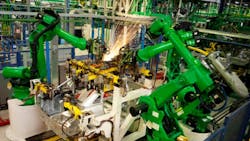Automation, Maintenance Markets Poised for Growth
The near-term industrial outlook is anything but rosy, but distributors in the electronics supply chain are looking for bright spots in an uncertain economic climate. Slow growth doesn’t mean no growth, they say, and it may be a matter of waiting for the political dust to settle before a clearer picture emerges.
“The rest of 2012 just doesn’t look very good. It’s sluggish with a couple of weeks reporting in October,” Allied Electronics’ Mark Simon said earlier in the quarter. And while he’s confident the business will return, he said, uncertainty surrounding the U.S. presidential election was putting a drag on business leaders’ decision-making processes through the fall.
Leading business indicators support that outlook, predicting continued slow growth for the U.S. manufacturing sector through the end of the year and into 2013. In its quarterly business outlook survey released in October, the Manufacturers’ Alliance for Productivity and Innovation predicted continued slowing growth in U.S. manufacturing over the next three to six months, noting that its quarterly composite index declined for the ninth straight time since June 2010. Although this was also the index’s largest decline, it still remains above the 50-point mark indicating growth, leading many to believe the manufacturing sector will continue to slow but won’t come to a screeching halt.
“This quarter’s survey results add an exclamation point to the view that manufacturing activity has slowed, but this is not to suggest that it is crashing,” said Donald A. Norman, MAPI senior economist and survey coordinator. “In fact, it is expected to expand, even if at a much slower rate than what we’ve experienced over the past two years.”
Distribution executives like Simon, Allied’s vice president of sales, point to the industrial automation and maintenance markets as pockets of strength in the manufacturing sector even as the slow growth continues. They also note customer trends toward cost and vendor base reductions as key issues to contend with.
Automation, Maintenance Bode Well
Simon described industrial automation business, a strong suit for Allied, as a particular bright spot on the horizon. Industrial automation projects are expected to grow in light of U.S. manufacturers’ drive to compete in the world economy, he said.
“[OEMs] are going to have to automate in order to survive in the States, which bodes well for us,” Simon explained, alluding to the distributor’s wide range of automation and control products and systems. “And as these manufacturers continue to find ways to automate, we’re working right alongside them.”
Such projects cut across a broad spectrum of industries, including service-based businesses and industrial plants alike that are looking for ways to gain efficiency through automation and control.
Maintenance projects offer a similar glimpse of light. Simon said the industrial maintenance market has been strong as the manufacturing sector has slowed. He also said he expects that to continue for the remainder of the year and into next year.
“Capital spending has been reduced, so manufacturers are looking to preserve equipment—get another season out of it, as my father-in-law would say,” Simon said. “There’s a lot of talk that people are holding on to cash reserves. Well, they’re certainly not spending it [on new equipment].”
Maintenance cuts across a wide range of industries as well, and the energy sector is one Simon called a particular bright spot over the last two years that is just beginning to dim. He said some customers are reporting a slowdown in the natural gas segment, while oil remains strong.
“I’ve spent the last two weeks in Houston and Oklahoma specifically, and they’ve seen a slowing since about July,” Simon said in early October. “Things are starting to contract a bit, and it has a lot to do with natural gas production and the cost of [natural gas] being down. The oil and petroleum side of the business is strong.”
Feeling The Financial Squeeze
Industrial customers are also putting the financial squeeze on suppliers as they seek to generate more revenue. They’re doing so by seeking greater increases on financial terms and deeper discounts on purchases, Simon explained.
“Especially in situations where companies have bought other companies, they’re starting to pull the lever and twist for better terms,” he said. “There’s a wave of customers asking for extended financial terms or discounts, finding any way they can to eke out some more revenue.”
This comes on top of a continued customer trend to “do more with less,” which places more pressure on distributors to step up with new and better services. This is especially evident online, said Simon, emphasizing suppliers’ continued investment in their Web offerings.
“This places more demand on external services like our Web site, as [customers] seek self-service options and the ability to work at the time it’s convenient for them,” Simon explained. “So we’ve invested millions and millions into our Web site so that we have good content, easy navigation—the right solutions to meet their needs.”
About the Author
Victoria Fraza Kickham
Distribution Editor
Victoria Kickham is the distribution editor for Electronic Design magazine, SourceESB and GlobalPurchasing.com, where she covers issues related to the electronics supply chain. Victoria started out as a general assignment reporter for several Boston-area newspapers before joining Industrial Distribution magazine, where she spent 14 years covering industrial markets. She served as ID’s managing editor from 2000 to 2010. Victoria has a bachelor’s degree in English from the University of New Hampshire and a master’s degree in English from Northeastern University.






